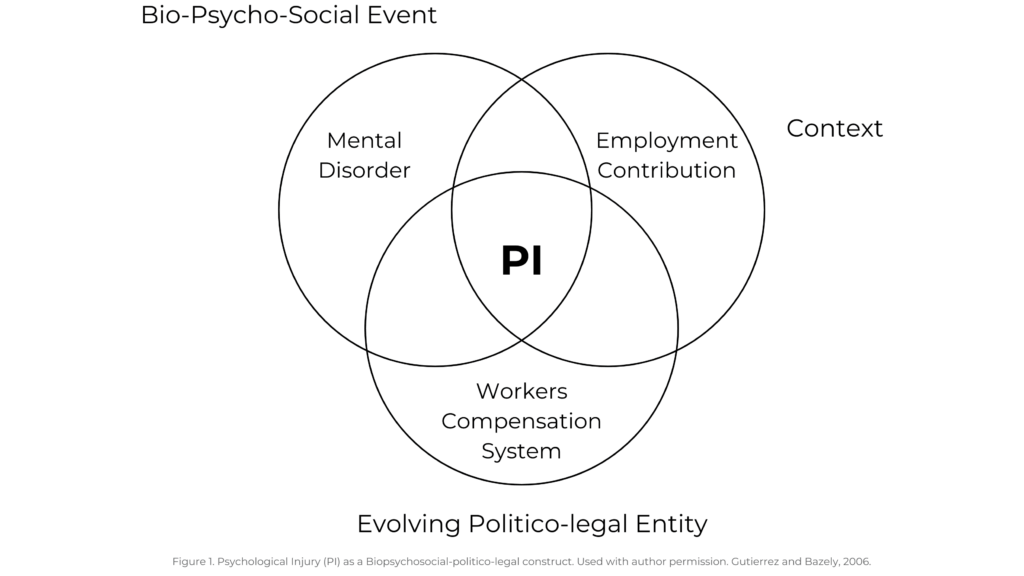Psychological injury claims are complicated on account of their intersectionality, as they are bio-psychosocial-politico-legal in naturei.
They have proven to be of increasing challenge to employers and regulators alike, on account of the escalating direct and indirect costs of prolonged claims duration. These challenges threaten the sustainability of our current schemes and are driving increases in workers compensation insurance costs to industry. The human cost is greater still.

Perceptions drive reality and treatment outcomes can be unpredictable
From the outset an important factor to be acknowledged is that when it comes to psychological injury, we are looking at conditions in which perceptions drive reality. Treatment outcomes against time are far less linear and predictable than those for physical injury claims.
The Safe Work Australia Model Code of Practice provides us with a list of hazards that have potential to cause psychosocial harm. Whilst we can list all these hazards with the assumption that they are all created equal, that their exposure parameters may be equivalent and that they have similar psychopathogenicity – we collectively have a fairly superficial understanding of the causative factors that lead to compensable psychological harm in the workplace.
There has been very scant research that deals with this topic directly. In the absence of relevant evidence, we have been applying stress–strain hypotheses that date back to the 1970’s, such as Karasek’s job demands-control modelii, to compensable psychological injury.
The role of employment contribution
In reality, remarkably few studies have been conducted to investigate what precipitates psychological injury claims as opposed to mental ill health outside of the workplace. In this article, we will be looking to psychological injury evidence that underpins one of the most critical psychosocial hazard domains, that is, the interpersonal domain.
The workers compensation data tells us that poorly managed hazards in the interpersonal domain contribute disproportionately to workplace psychological injury. Of around 10,000 serious psychological injury claims in 2021-22iii, the highest proportion (27.5%), were attributed to workplace bullying and/or harassment.
In this article, we will shed some light on an interesting piece of research from 2006 that reviewed over 157 NSW based psychological injury claims. At the time, this was representative of approximately 10% of all claimants for the state in a given year. The research pointed to a specific precipitating factor as being particularly psychopathogenic. One that too sits in the interpersonal domain and which can indeed be in itself a precursor to some forms of bullying: interpersonal conflict and more specifically, conflict that has become interpersonalised.
Interpersonal Conflict at Work
According to the Psychosocial Code of Practice, Conflict arises from “poor workplace relationships or interpersonal conflict between colleagues or from other businesses, clients or customers. Frequent disagreements, disparaging or rude comments, either from one person or multiple people, such as from clients or customers.”
Interpersonal conflict occurs on a spectrum. At the pointier end, it can best be conceptualised as a side-effect of work based human relationships breaking down. Conflict can and does take many forms and has been called by many names: from workplace incivility, horizontal violence to counter productive behaviours. Yet there is something about interpersonal conflict that makes it critically important to anyone wishing to make an impact on psychological injuries. In seminal research conducted by Gutierrez and Bazely in 2006, the authors found that interpersonal conflict was a precipitating factor, predictive of the development of psychopathology, at a higher rate than any other hazard in their review of compensable psychological injuries in NSW.

Speak to Karolina to find out more on how organisations can effectively manage interpersonal conflict to create healthier work environments.
Interpersonal Conflict vs Interpersonalised Conflict
In their analysis, they further concluded that there are several things about interpersonal conflict that make it particularly noteworthy. Firstly, claimants who reported the presence of conflict were more likely to have their claim accepted by their insurer. Secondly, there was a specific type of conflict which they found to be particularly concerning. They termed this kind of conflict ‘interpersonalised’ conflict. The main difference between this and other types of conflict situations was the perceived presence of a value judgement on the claimant, by the other involved party/parties, which was construed by the claimant as being particularly adverse and unfair. It was the personalisation of that value judgement that frequently led to emotional distress.
Further, interpersonalised conflict frequently served as a trigger to claim submission. Meaning that conflict tended to precipitate claim submission behaviour.

Conflict Blindness
The research concluded that when interpersonal conflict was present in a claim for compensation, employers denied the presence of conflict, even when it had been established by an independent psychologist in review. This ‘conflict blindness’ then became a contributing factor to the claim, as it impacted the way the claimants perceived they were believed and treated by their employer.
From all this, it becomes apparent that dealing with interpersonal conflict before it escalates and especially before it becomes personalised, should be of high priority to health and safety and HR leaders wanting to make a difference to their psychological injury claim rates. But where to begin? There are multiple points of potential intervention to disrupt the process and prevent adverse outcomes.
Are we asking the right questions?
Some questions that leaders may find useful to begin exploring the As-Is state of their organisations when it comes to conflict include:
1/ Is healthy conflict normalised in our organisation?
In some cultural groups, healthy conflict and disagreement/argument is not only entirely normalised, but encouraged, as the purpose of argument is to advance the matter under discussion, rather than about proving the one or the other right/wrong. That is, where the notion is: may the best idea win. Conflict is not in and of itself always adverse. In fact, healthy conflict can frequently help ideas arise and progress our collective understanding of nuance. Arguing different points of view leads to clarification of problems and can help people come together in the finding of solutions.
2/ Do we know our organisation’s baseline level of conflict?
Every organisation has a baseline that sets the tone for how individuals interact, compete for resources, and manage conflict. Establishing a base-line level of conflict is helpful in making inter departmental comparisons and finding hotspots. In addition, the difference in perception of conflict between supervisors and non-supervisors vs senior leaders can also point to the presence or absence of the conflict blindness discussed above. It can be helpful to undertake an assessment that includes the review of policies and practices followed by tailored and fit for purpose interventions that include capability lifting where appropriate.
3/ Does our leadership model healthy conflict?
According to a recent report from The Workforce Institute, based on a survey of 3,400 employees and managers in 10 countries, managers have as much of an impact on employee mental health as their spouse and even more of an impact than their doctor or therapist. When leaders model the handling of conflict effectively, they set the tone for the parameters of behaviours that are acceptable. This can contribute to a culture of healthy conflict, or conversely, one that lends itself to power play, personalisation and division.
4/ Do we have an integrated approach to the management of conflict?
Interpersonal conflict is complicated and cannot be left to a single function to manage effectively. Similarly, no set of policies, processes or procedures alone stand to resolve the issue, as these lend themselves to weaponisation and selective use, which can further marginalise those individuals who are impacted.
The Takeaway
In summary, workplace psychological injury claims continue to escalate. It is an oversimplification to be reliant on job-stress-strain models alone to hold the answers to such a multifactorial phenomenon. Psychological injury claims pose an increasing financial challenge to the sustainability of workers compensation schemes and come at a great personal cost to people, families and communities. Hazards in the interpersonal domain are significantly overrepresented in the workers compensation data when compared against other contributing factors.
It is unrealistic however, to expect that employers can make this shift alone. Employers can normalise healthy conflict and role model what it looks like to progress an argument or disagreement in a healthy way. In truly embracing diversity and inclusion in the workplace, there is a call to action for the whole workforce to include diversity of thought and opinion, without resorting to personalisation, division or conversely, weaponised offence. This may serve to protect those finding themselves in conflict from internalising, which is the point at which harm is more likely to occur.
Let’s connect
To find out more about effectively managing interpersonal conflict to create healthier work environments, fill in the form below, or alternatively, you can get in touch with Karolina Dobson directly on:
m: +61 404 766 769
e: karolina.dobson@safetyworks.com.au
References:
i Gutierrez, R and Bazely, P (2006). Workplace Psychological Injury: A Mixed Methods Investigation Into Workers’ Compensation Claims. Research Summary Report for Stakeholders.
ii Karasek, R. A. (1979, June). Job Demands, Job Decision Latitude, and Mental Strain: Implications for Job Redesign. Administrative Science Quarterly, 24(2), 285
iii Safe Work Australia (2024). Data report Psychological health and safety in the workplace.

